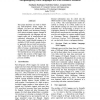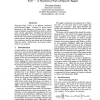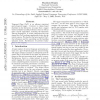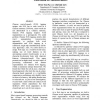15 search results - page 2 / 3 » A Maximum Entropy Approach to FrameNet Tagging |
ACL
2006
13 years 6 months ago
2006
We proposed a subword-based tagging for Chinese word segmentation to improve the existing character-based tagging. The subword-based tagging was implemented using the maximum entr...
ACL
2007
13 years 6 months ago
2007
This paper describes our work on building Part-of-Speech (POS) tagger for Bengali. We have use Hidden Markov Model (HMM) and Maximum Entropy (ME) based stochastic taggers. Bengali...
ANLP
2000
13 years 6 months ago
2000
Trigrams'n'Tags (TnT) is an efficient statistical part-of-speech tagger. Contrary to claims found elsewhere in the literature, we argue that a tagger based on Markov mod...
CORR
2000
Springer
13 years 5 months ago
2000
Springer
Trigrams'n'Tags (TnT) is an efficient statistical part-of-speech tagger. Contrary to claims found elsewhere in the literature, we argue that a tagger based on Markov mod...
EMNLP
2004
13 years 6 months ago
2004
Chinese part-of-speech (POS) tagging assigns one POS tag to each word in a Chinese sentence. However, since words are not demarcated in a Chinese sentence, Chinese POS tagging req...




